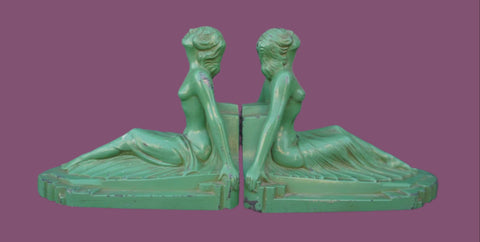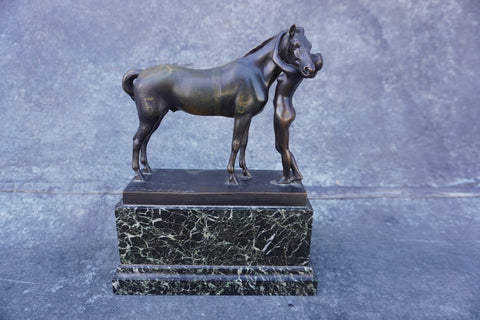George Hurrell portrait of Marion Davies for MGM 1929 P632
Spectacular original photograph by Hurrell. Beautiful condition: With studio notation
Marion Davies (January 3, 1897 – September 22, 1961) was an American film actress, producer, screenwriter, and philanthropist. Davies was already building a reputation as a popular film comedienne when newspaper tycoon William Randolph Hearst, with whom she began a relationship, took over management of her career. Hearst promoted her heavily through his newspapers, and pressured studios to cast her in historical dramas to which she was not suited. For this reason, Davies is better remembered today as Hearst’s mistress and hostess at many lavish events for the Hollywood elite than for her acting. In particular, her name is linked with the 1924 scandal aboard Hearst’s yacht when one of his guests, film producer Thomas Ince, died. In the film Citizen Kane (1940), the title character’s wife – an untalented singer whom tries to promote – was widely assumed to be based on Davies. But many commentators, including Citizen Kane’s writer/director Orson Welles himself, have defended Davies’ record as a genuinely gifted actress, to whom Hearst’s patronage did more harm than good. She retired from the screen in 1937 choosing to devote herself to Hearst and charitable work. In Hearst’s declining years, Davies provided both emotional and financial support until his death in 1951. She married for the first time eleven weeks after his death. Davies died in 1961.
George Hurrell (June 1, 1904 – May 17, 1992) was a photographer who made a significant contribution to the image of glamour presented by Hollywood during the 1930s and 1940s. Born in Covington, Kentucky, Hurrell originally studied as a painter with no particular interest in photography. He first began to use photography only as a medium for recording his paintings. After moving to Laguna Beach, California from Chicago, Illinois in 1925 he found that photography was a more reliable source of income than painting. His photography was encouraged by his friend aviatrix Pancho Barnes, who often posed for him. He eventually opened a photographic studio in Los Angeles.
Career In Hollywood
In the late 1920s, Hurrell was introduced to the actor Ramon Novarro, by Pancho Barnes, and agreed to take a series of photographs of him. Novarro was impressed with the results and showed them to the actress Norma Shearer, who was attempting to mould her wholesome image into something more glamorous and sophisticated in an attempt to land the title role in the movie The Divorcee. She asked Hurrell to photograph her in poses more provocative than her fans had seen before. After she showed these photographs to her husband, MGM production chief Irving Thalberg, Thalberg was so impressed that he signed Hurrell to a contract with MGM Studios, making him head of the portrait photography department. But in 1932, Hurrell left MGM after differences with their publicity head, and from then on until 1938 ran his own studio at 8706 Sunset Boulevard.
Throughout the decade, Hurrell photographed every star contracted to MGM, and his striking black-and-white images were used extensively in the marketing of these stars. Among the performers regularly photographed by him during these years were silent screen star Dorothy Jordan, as well as Myrna Loy, Robert Montgomery, Jean Harlow, Joan Crawford, Clark Gable, Rosalind Russell, Carole Lombard and Norma Shearer, who was said to have refused to allow herself to be photographed by anyone else. He also photographed Greta Garbo at a session to produce promotional material for the movie Romance. The session didn’t go well and she never used him again.
In the early 1940s Hurrell moved to Warner Brothers Studios photographing, among others Bette Davis, Ann Sheridan, Errol Flynn, Olivia de Havilland, Alexis Smith, Maxine Fife, Humphrey Bogart and James Cagney. Later in the decade he moved to Columbia Pictures where his photographs were used to help the studio build the career of Rita Hayworth.
Postwar
He left Hollywood briefly to make training films for the First Motion Picture Unit of the United States Army Air Forces. When he returned to Hollywood in the mid 1950s his old style of glamour had fallen from favour. Where he had worked hard to create an idealised image of his subjects, the new style of glamour was more earthy and gritty, and for the first time in his career Hurrell was not seen as an innovator. He moved to New York where he worked for fashion magazines and photographed for advertisements before returning to Hollywood in the 1960s.
Renaissance
An exhibition of his work at the Museum of Modern Art in New York in 1965 caused a revival of interest, and he continued to work sporadically. By the 1970s he was photographing such celebrities as Raquel Welch, Cher, Farrah Fawcett and John Travolta. He officially retired in 1976 but would still take photographs if he was particularly interested in the subject. Sharon Stone and Brooke Shields were two stars he felt conveyed the type of glamour he enjoyed photographing, and they posed for him several times during the 1980s . In 1984 when Joan Collins was asked to pose for Playboy at the age of 50 she insisted that the only photographer she would accept was Hurrell, he photographed Collins in a nude 12 page layout and the issue became a bestseller. Among his last works were production stills featuring Warren Beatty and Annette Bening for the film Bugsy and the cover artwork for the Natalie Cole album Unforgettable… with Love. In 1992, during the making of a documentary about his career, he took a series of photographs of actors Sherilyn Fenn, Sharon Stone, Julian Sands, Raquel Welch, Eric Roberts and Sean Penn. In these portraits he recreated his style of the 1930s, with these actors posing in costumes, hairstyle and makeup of the period.
Death
Hurrell died shortly after completing the documentary from complications from his long standing problem with bladder cancer. When his doctors delivered the message to him that he had perhaps only a day left to live, he replied, “Well, the party is over. Time to go home.” He died on May 17, 1992.
Since his death, his works have appreciated in value and are highly sought after as fine art by collectors.











